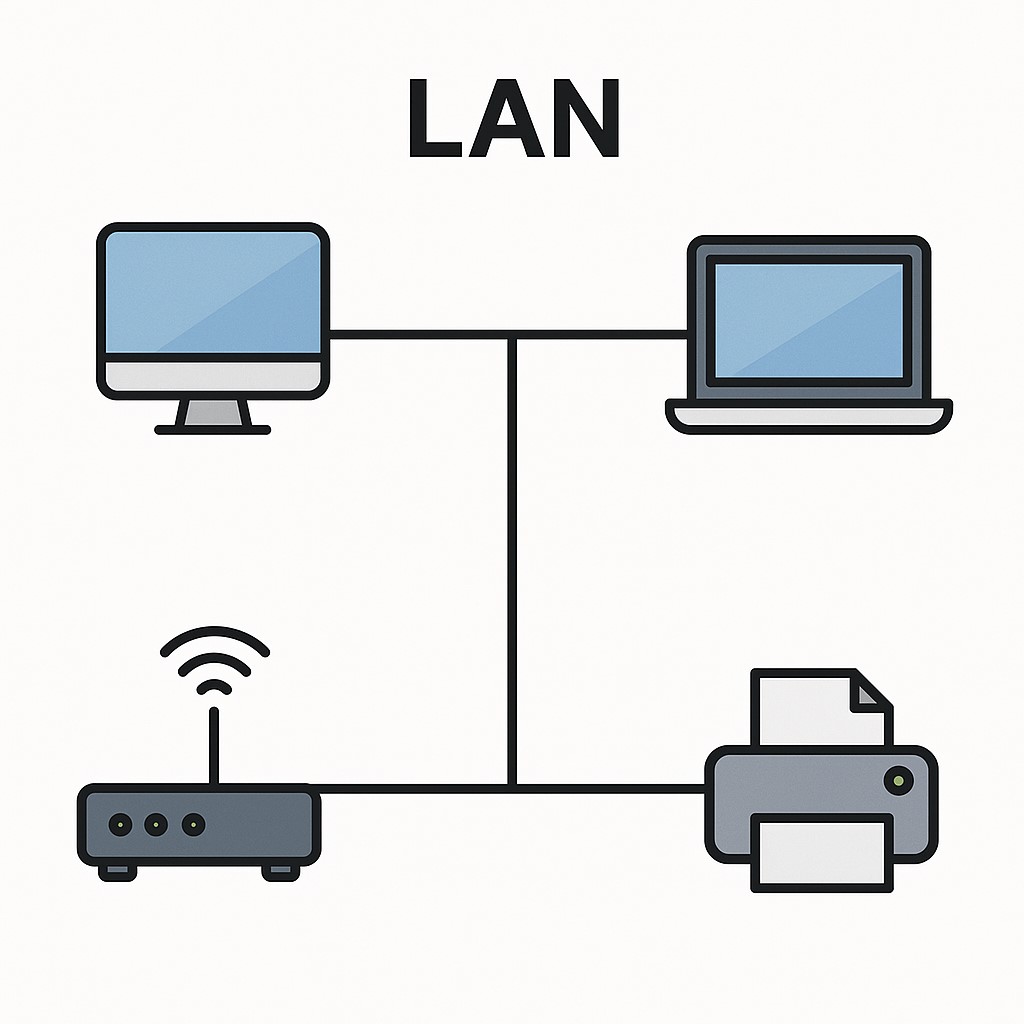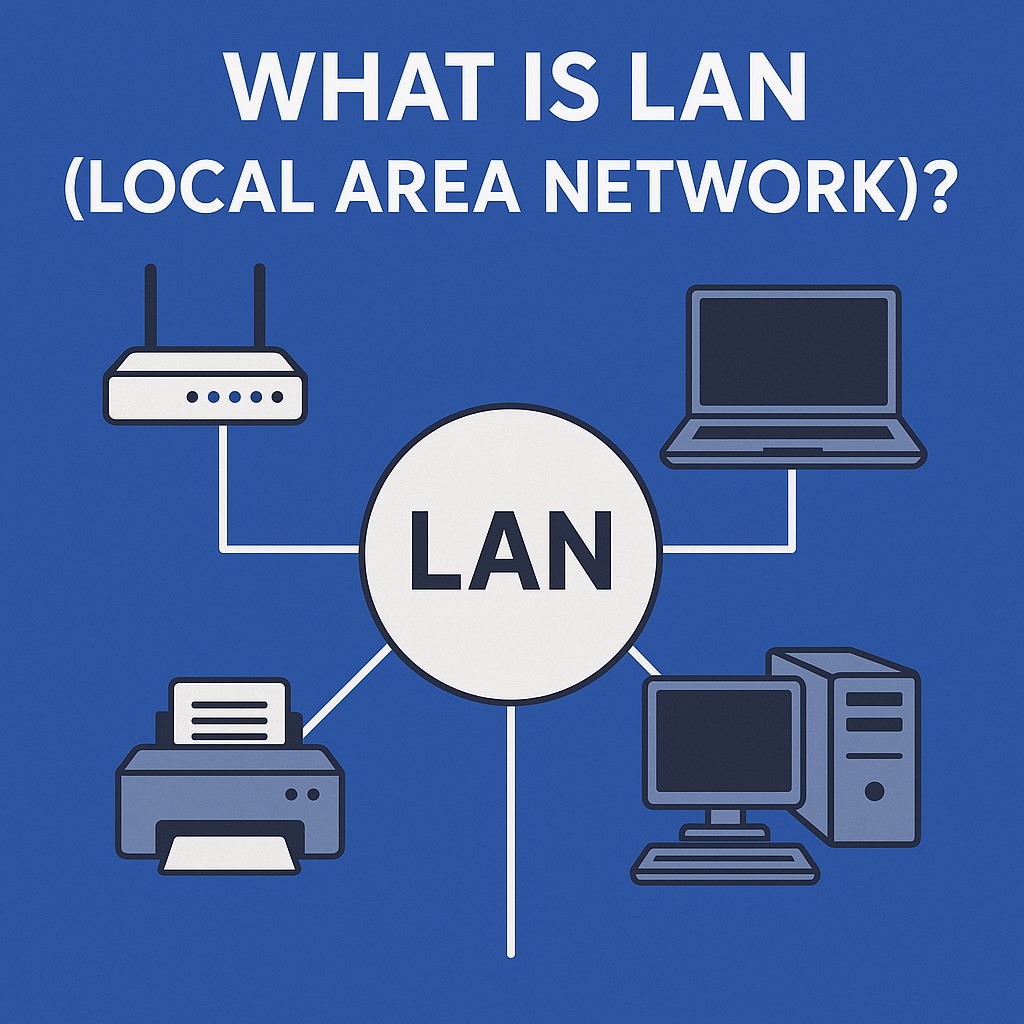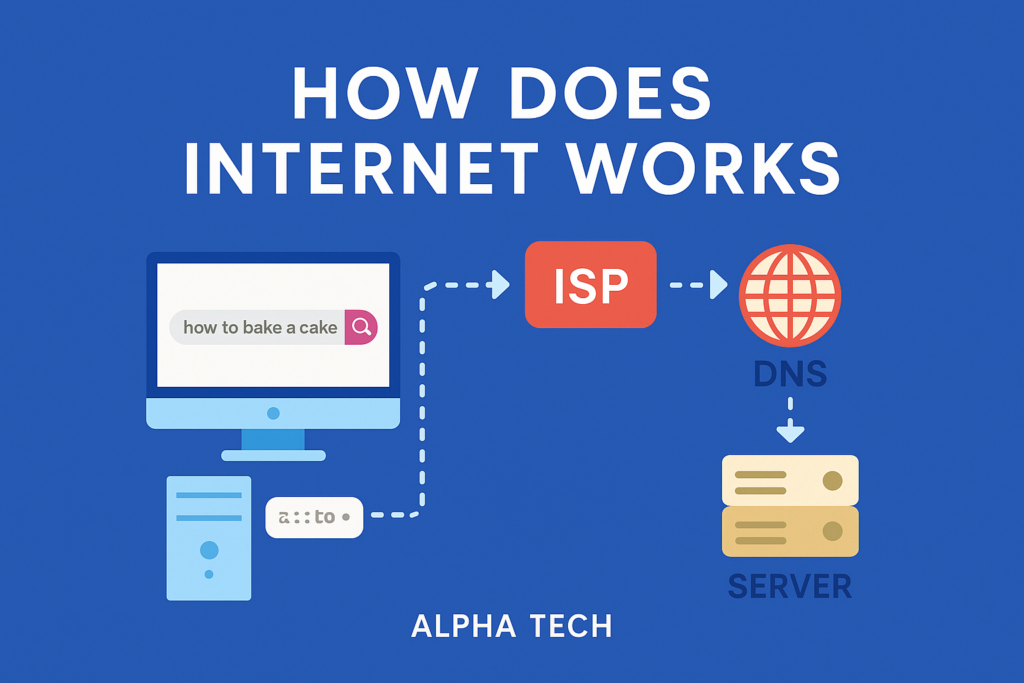Introduction to LAN
What is LAN (local area network)?
A LAN (Local Area Network) is a type of computer network that connects devices within a limited area such as a home, school, office building, or campus. Unlike wide-area networks (WANs) that cover large distances, a LAN is confined to a small geographical region.

It allows connected devices like computers, printers, and servers to communicate and share resources such as files, software, and internet connections.
Real-Life Examples of LAN
To better understand LAN, let’s look at some everyday examples:
- Home Network: Connecting your laptop, smart TV, and smartphone to the same Wi-Fi router at home.
- School Network: A computer lab where all PCs are connected to a central server for file sharing and internet access.
- Office Network: Employees’ computers connected to each other and to shared printers or databases within the same building.
These are all classic examples of LANs that make digital communication smooth and efficient within a limited space.
Importance of LAN in Today’s Digital World
In the era of fast and efficient communication, LAN plays a crucial role:
- It enables quick data sharing among multiple devices.
- Reduces hardware and software costs by allowing resource sharing.
- Improves collaboration and productivity in schools, businesses, and homes.
- LAN is also the foundation of many modern technologies like smart homes, gaming networks, and IoT (Internet of Things) systems.
Without LANs, the digital ecosystem that we rely on daily would be far less efficient, slower, and more expensive to manage.
Working Of LAN-
How Does a LAN Work? (In-Depth Explanation)
A Local Area Network (LAN) is designed to connect multiple devices within a small area like a home, office, or school building so they can communicate and share resources such as internet, files, and printers. Here’s how this process actually works—step by step.
=> Step 1: Devices Connect to the Network
To form a LAN, each device (like a computer, smartphone, printer, or smart TV) must be physically or wirelessly connected to a central network device. This is usually done in two ways:
- Wired Connection: Using Ethernet cables (RJ45) that plug into a network switch or router.
- Wireless Connection: Using Wi-Fi via a wireless router or access point.
Each connected device must have a Network Interface Card (NIC)—either built-in or external—which allows it to send and receive data on the network.
=>Step 2: Central Device Manages Communication
In most LAN setups, there’s a central device that manages all traffic within the network:
- Router – If internet access is needed, the router manages connections between LAN devices and the internet.
- Switch – If the LAN is internal-only (no internet), a switch is used to distribute data among connected devices efficiently.
Each device on the LAN gets a local IP address (like 192.168.1.2), which is unique within the network. This is how devices are identified and communicate.
=> Step 3: Data Is Transmitted Using Protocols
Once devices are connected, they talk to each other using networking protocols—rules that define how data is formatted, transmitted, and received.
The most common protocol is TCP/IP (Transmission Control Protocol / Internet Protocol).
- TCP ensures data is sent accurately and in the correct order.
- IP handles addressing and delivery of packets between devices.
So, when you send a file from your PC to a printer:
- The file is broken into small data packets.
- Packets travel through the LAN using cables or Wi-Fi.
- The printer receives the packets, reassembles them, and prints the file.
=> Step 4: Devices Share Resources

In a LAN, connected devices can share various resources like:
- Files & Folders: Easily transfer documents between computers.
- Printers & Scanners: Multiple devices can use the same printer.
- Internet Connection: All devices can access the internet through a single router.
- Software Applications: Run shared apps or access shared databases.
=> Example: A Simple LAN in Action
Let’s say you have this setup at home:
- A Wi-Fi router is placed in your living room.
- Your laptop connects via Wi-Fi.
- Your desktop PC connects using a cable.
- A wireless printer is also connected to the router.
Now:
- You can print documents from either the laptop or desktop.
- You can share files between the two computers.
- All devices can browse the internet simultaneously.
All of this communication happens within milliseconds, thanks to the fast and local nature of LAN.
Security in LAN
Since all devices are connected locally, security is also important:
- Use strong passwords for Wi-Fi.
- Enable firewalls and encryption.
- Limit access using MAC filtering or IP whitelisting.
Types of LAN: Explained with Examples
While all LANs (Local Area Networks) serve the same purpose—connecting devices within a limited area—there are different types of LAN setups based on how devices communicate and the network is managed. Let’s explore the two main types:
1. Client-Server LAN
🖥️ What It Is:
In a client-server LAN, one or more computers (called clients) are connected to a central server that manages resources and controls access.
🔧 How It Works:
- The server stores files, applications, and data.
- Clients request services from the server.
- The server responds to those requests, such as file access, internet sharing, or printing.
✅ Example:
- Office Network: Employees’ PCs (clients) are connected to a central file server that stores company documents.
- School Computer Lab: Students access shared educational software from a server.
👍 Advantages:
- Centralized control and management
- Easier backup and security
- Scalable for larger networks
👎 Disadvantages:
- Costly setup (requires a dedicated server)
- Server failure can affect the whole network
2️⃣ Peer-to-Peer (P2P) LAN
🖥️ What It Is:
In a peer-to-peer LAN, there is no dedicated server. All devices (peers) are equal and can share resources directly with each other.
🔧 How It Works:
- Each computer can act as both client and server.
- Devices can send and receive files or access shared resources without a central server.
✅ Example:
- Home Network: Your laptop and desktop share a folder to exchange photos or music files.
- Small Office: 3–5 employees connect their PCs to a shared printer without any server.
👍 Advantages:
- Easy and cheap to set up
- No need for a dedicated server
👎 Disadvantages:
- Harder to manage on a large scale
- Less secure and organized than client-server networks
🔄 Quick Comparison Table
| Feature | Client-Server LAN | Peer-to-Peer LAN |
|---|---|---|
| Server Required | Yes | No |
| Setup Cost | Higher | Lower |
| Security | More secure (central control) | Less secure |
| Best For | Large offices, institutions | Homes, small teams |
Key Features of LAN Networks
A LAN (Local Area Network) has several important features that make it fast, efficient, and ideal for small areas like homes, schools, or offices:
- High Speed: LANs offer fast data transfer (100 Mbps to 10 Gbps), perfect for file sharing, gaming, or video calls.
- Limited Area: Works within a small range—like one building or a campus.
- Resource Sharing: Devices can share files, printers, internet, and apps with each other easily.
- Centralized Control: In client-server LANs, one server manages the whole network (users, files, security).
- Low Latency: Communication is very quick due to short distances between devices.
- Cost-Effective: LANs are affordable to set up and maintain, especially in small environments.
- Good Security: Private and secure, especially with passwords, firewalls, and user controls.
Advantages of using LAN:
- File Sharing: LAN allows easy sharing of files and resources like printers, which improves collaboration.
- Cost-effective: Sharing hardware resources like printers or internet connections helps reduce costs.
- High Speed: LAN networks generally offer high data transfer speeds, which enable fast communication between devices.
- Centralized Data Management: Data can be stored in a central location, making backup and security easier to manage.
- Security: It’s easier to implement network security measures such as firewalls and anti-virus software on a LAN.
- Scalability: LANs can be expanded easily by adding more devices to the network.
Disadvantages of using LAN:
- Security Risks: A LAN is vulnerable to internal and external threats if not secured properly.
- Limited Range: LANs are typically limited to a small area (like a building or campus), and extending them over long distances can be expensive.
- Maintenance: Managing a LAN requires regular maintenance and monitoring to ensure its reliability and security.
- Traffic Congestion: High usage can lead to network congestion and slower speeds.
- Hardware Dependency: LAN depends on the reliability of network hardware (routers, switches, etc.), which can be costly to maintain or upgrade.
Essential Role Of These Devices in LAN-
1. Network Interface Card (NIC)
- Role: A NIC is a hardware component that allows a device (such as a computer or printer) to connect to a network, either wired (Ethernet) or wireless (Wi-Fi). It provides the physical interface for communication on the network.
- Function: It converts data from the device into a format that can be transmitted over the network and vice versa.
2. Switch
- Role: A switch is a network device that connects multiple devices in a LAN and allows them to communicate with each other.
- Function: It forwards data packets between devices within the same network. Unlike a hub, which broadcasts data to all devices, a switch intelligently sends data only to the specific device it is intended for, reducing network congestion.
3. Router
- Role: A router is a device that connects multiple networks, such as a local area network (LAN) to a wide area network (WAN) or the internet.
- Function: It routes data packets between different networks and ensures that data sent from the LAN reaches its correct destination, like an external server or another network. It also manages network traffic, assigns IP addresses (via DHCP), and provides network security (firewall).
4. Cables
- Role: Cables are the physical medium used to connect devices in a network.
- Function: Common types of cables include Ethernet cables (Cat5, Cat6) used for wired connections. They transmit data signals between devices (computers, switches, routers) and ensure the proper flow of data over the network. Fiber-optic cables may also be used for high-speed and long-distance connections.
Kmow more about network devices – Network Interface Card , Switch, Router
Conclusion: Why Understanding LAN is Important–
Understanding how a Local Area Network (LAN) works is very important, especially in today’s digital world where computers and devices need to communicate with each other quickly and securely.
Summary of Benefits:
- LAN helps in sharing files, printers, and internet easily between computers in a small area like a home, school, or office.
- It is cost-effective, fast, and makes data management easier.
- LAN also improves teamwork and communication within a group or organization.
Encouragement to Explore More:
Learning about LAN is just the first step in the world of networking. Once you understand it, you can explore more advanced topics like WAN (Wide Area Network), IP addressing, cybersecurity, wireless networking, and how the internet works. These skills are very useful in careers related to IT, software development, cybersecurity, and more.
👉 Start small, stay curious, and keep learning!
learn more about Computer network click
For more blog related to tech visit my site



